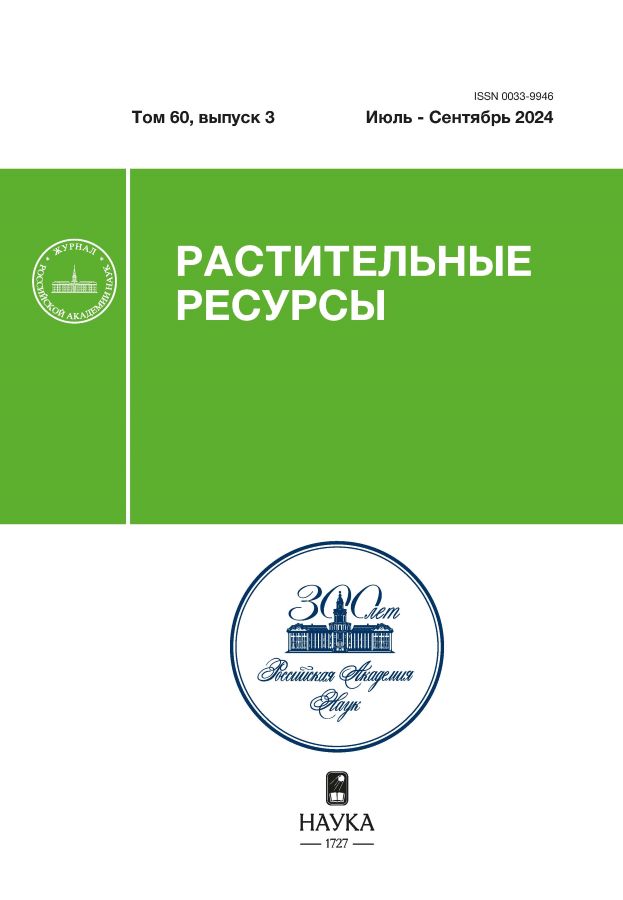Biologically active substances and antioxidant activity of Spiraea humilis (Rosaceae) in vitro
- Authors: Kostikova V.A.1, Petruk A.A.1, Veklich T.N.2, Petrova N.V.3
-
Affiliations:
- Central Siberian Botanical Garden, SB RAS
- Amur Branch of Botanical Garden-Institute, FEB RAS
- Komarov Botanical Institute of RAS
- Issue: Vol 60, No 3 (2024)
- Pages: 99-110
- Section: Component Composition of Resource Species
- URL: https://ruspoj.com/0033-9946/article/view/674404
- DOI: https://doi.org/10.31857/S0033994624030073
- EDN: https://elibrary.ru/PTSEIQ
- ID: 674404
Cite item
Abstract
The total content of phenolic compounds, including catechins, flavonols, phenolcarboxylic acids, and the antioxidant activity of aqueous-ethanol extracts from the above-ground organs of Spiraea humilis Pojark. from two Far Eastern populations were studied. It has been established that plant leaves contain more phenolcarboxylic acids and flavonols (population from the environs of Selikhino village, Khabarovsk Territory). Plant inflorescences contain more catechins, phenolic compounds, flavonols (population from the environs of Komsomolsk-on-Amur, Khabarovsk Territory). Plant stems were inferior in content of the studied compounds to leaves and inflorescences. Studies have shown that the antioxidant activity of water-ethanol extracts from leaves and stems of S. humilis is significantly lower than from inflorescences. From the correlation analysis, it was found that antioxidant activity is significantly positively related to the total content of phenolic compounds, mainly flavonols and catechins, in Spiraea organs. Phenolcarboxylic acids have the least effect on neutralizing 1,1-diphenyl-2-picrylhydrazyl (DPPH) free radicals. Fifteen phenolic compounds with high biological activity were identified in aqueous-ethanol extracts from aerial organs of S. humilis by high-performance liquid chromatography. Differences in the profiles of phenolic compounds of plants from two Far Eastern populations were established. Of the identified phenolic compounds, the flavonols, quercitrin, rutin and quercetin make the greatest contribution to the antioxidant activity of the extracts. A preliminary assessment of plant materials showed that S. humilis accumulates a sufficient amount of biologically active substances in above-ground vegetative and generative organs and can be recommended as a promising source of antioxidants and other biologically active substances.
Keywords
Full Text
About the authors
V. A. Kostikova
Central Siberian Botanical Garden, SB RAS
Email: NPetrova@binran.ru
Russian Federation, Novosibirsk
A. A. Petruk
Central Siberian Botanical Garden, SB RAS
Email: NPetrova@binran.ru
Russian Federation, Novosibirsk
T. N. Veklich
Amur Branch of Botanical Garden-Institute, FEB RAS
Email: NPetrova@binran.ru
Russian Federation, Blagoveshchensk
N. V. Petrova
Komarov Botanical Institute of RAS
Author for correspondence.
Email: NPetrova@binran.ru
Russian Federation, St. Petersburg
References
- Tseylikman V. E., Lukin A. A. 2022. On the effect of oxidative stress on the human body. — International Research Journal. 3(117): 206–211. https://doi.org/10.23670/IRJ.2022.117.3.037 (In Russian)
- Gurbanov R. G., Dzhambetova P. М. 2022. Study of genotoxicity and oxidative stress of medicinal plants in mountain territories of the Chechen Republic. — Natural Systems and Resources. 12(2): 43–50. https://doi.org/10.15688/nsr.jvolsu.2022.2.6 (In Russian)
- Chaudhary P., Janmeda P., Docea A. O., Yeskaliyeva B., Abdull Razis A. F., Modu B., Calina D., Sharifi-Rad J. 2023. Oxidative stress, free radicals and antioxidants: potential crosstalk in the pathophysiology of human diseases. — Front. Chem. 11: 1158198. https://doi.org/10.3389/fchem.2023.1158198
- [Plant Resources of Russia: Wild flowering plants and their component composition and biological activity. T. 2: Family Actinidiaceae–Malvaceae, Euphorbiaceae–Haloragaceae]. 2009. St. Petersburg; Moscow. 513 p. (In Russian)
- Batorova S. M., Yakovlev G. P., Aseeva T. A. 2013. [Medicinal plants of traditional Tibetan medicine: A handbook]. Novosibirsk. 290 p. (In Russian)
- Krivosheev I. M. 2014. [Pharmacognostic study of Spiraea salicifolia L. growing in Eastern Siberia: Absrt… Diss. Cand. (Pharmacy) Sci.]. Irkutsk. 22 с. (In Russian)
- Kostikova V. A., Petrova N. V. 2021. Phytoconstituents and bioactivity of plants of the genus Spiraea L. (Rosaceae): a review. — Int. J. Mol. Sci. 22(20): 11163. https://doi.org/10.3390/ijms222011163
- Mirovich V.M., Krivosheev I.M., Gordeeva V.V., Tsyrenzhapov A.V. Method for producing agent possessing anti-inflammatory, diuretic and antioxidant activity. Russian Patent RU 2542493C1. Appl. 8 November 2013. https://patents.s3.yandex.net/RU2542493C1_20150220.pdf (In Russian)
- Poyarkova A. I. 1939. Genus Spiraea — Spiraea L. — In: Flora URSS. Moscow. Vol. 9. P. 283–305.
- Polozhiy A. V. 1988. [Genus Meadowsweets. – Spiraea L.] — In: [Flora of Siberia]. Novosibirsk. Vol. 8. Pp. 10–20. (In Russian)
- Yakubov V. V. 1996. [Genus Meadowsweets. – Spiraea L.] — In: [Vascular plants of the Soviet Far East]. St. Petersburg. Vol. 8. P. 130–136.
- Koropachinskiy I. Yu., Vstovskaya T. N. 2002. [Woody plants of the Asian part of Russia]. Novosibirsk. 707 p. (In Russian)
- Djeridane A., Yousfi M., Nadjemi B., Boutassouna D., Stocker P., Vidal N. 2006. Antioxidant activity of some Algerian medicinal plants extracts containing phenolic compounds. — Food Chem. 97(4): 654–660. https://doi.org/10.1016/j.foodchem.2005.04.028
- Belikov V. V., Shraiber M. C. 1970. [Methods for the analysis of flavonoid compounds]. — Farmatsiya. 19(1): 66–72. (In Russian)
- Kukushkina T. A., Zykov A. A., Obukhova L. A. 2003. [Lady's mantle (Alchemilla vulgaris L.) as a source of medicines of natural origin]. — In: [Contemporary problems of the development of new drugs of natural origin: Proceedings of the VIIth International Congress]. St. Petersburg. P. 64–69. (In Russian)
- Gawron-Gzella A., Dudek-Makuch M., Matławska I. 2012. DPPH radical scavenging activity and phenolic compound content in different leaf extracts from selected blackberry species. — Acta Biol. Cracov., Bot. 54(2): 32–38. https://doi.org/10.2478/v10182-012-0017-8
- Van Beek T. A. 2002. Chemical analysis of Ginkgo biloba leaves and extracts. — J. Chromatogr. A. 967(1): 21–55. https://doi.org/10.1016/S0021-9673(02)00172-3
- Gawron-Gzella A., Witkowska-Banaszczak E., Bylka W., Dudek-Makuch M., Odwrot A., Skrodzka N. 2016. Chemical composition, antioxidant and antimicrobial activities of Sanguisorba officinalis L. extracts. — Pharm. Chem. J. 50(4): 244–249. https://doi.org/10.1007/s11094-016-1431-0
Supplementary files













